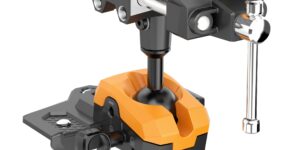AUTOMATION CONSUMABLES: ARE YOU GETTING YOUR MONEY'S WORTH'
Diane Steadham of Tweco explores the options that are necessary to determine the correct type of welding automation consumables needed for given applications.
Posted: September 1, 2009
In welding automation, manufacturers must make decisions daily on equipment selection and choices. Selections are based on what equipment is necessary for each process, while choices depend upon the discretion of the individual welder. Choices are often the most difficult to measure as a return on investment.
One choice in particular ? consumables ? is one of the most discussed issues in automation. Though they represent the least expensive and smallest piece of the automation system, these small parts can add up as they require frequent replacement.
The fact is that there are a variety of choices and options available, but by truly understanding each consumable?s added benefits and expectations, any professional will be able to select the right part to meet a given situation.
MATERIAL AND STYLE OPTIONS
As an industry, we continue to explore a variety of materials for consumables. Each available selection provides unique opportunities for adding value in your production process. For example, consider contact tips and nozzles. There are three preferred types of alloys for contact tips: copper-silver, chrome zirconium and standard copper.
The copper-silver alloy has properties such as low service temperature, electrical resistance and electrical conductivity that greatly reduce erosion, arc instability and poor arc starting characteristics. That means these tips promote good arc start, as well as longevity. On the other hand, chrome zirconium, which is used in high-heat applications, is a harder material than pure copper ? increasing its wear resistance properties and allowing for longer life in an operating application, particularly one involving excessive heat.
Although standard copper doesn?t produce as hard of a finish as chrome zirconium, it has been around for years and is the material of choice for gas metal arc welding (GMAW) applications. Due to its high electrical conductivity and availability, it exhibits the best electrical conductivity compared to all copper grades.
When considering nozzle material, standard copper alloy or nickel-plated copper alloy, and occasionally brass, are just a few choices you have to select from. The standard copper alloy, which is fairly easily machined, is widely used for piping gas, liquefied petroleum gas, natural gas, water heaters and kitchen ranges.
The value of nickel-plated copper alloy, which is suitable for any type of industry production, is that it helps decrease the amount of spatter build-up. Spatter build-up can interrupt production by creating arcs and accumulating to the point where production must stop to hand-clean the machine. By reducing downtime and required machine maintenance through use of the correct nozzle material, manufacturers can increase production volume and lower labor costs.
Contact tip and nozzle style is another consideration for many professional welders. Within consumables, different styles offer various qualities for reachability and enhanced efficiency. For example, for access into hard-to-reach spaces that would otherwise be inaccessible, the straight bore or bottleneck front-end nozzles are recommended. Or when selecting contact tips, one could choose a standard thread or cam-lock/quick-lock version.
Cost-wise, the variety of difference in cost depends upon the material and style selected. The welder?s needs, as well as the consumable?s function in the facility, will help determine not only the best selection, but the ultimate cost. Each alternative is unique in its own way, but selection depends upon the application and desired result. Ultimately, the decision comes down to which option best fits your situation.
WHAT?S YOUR PERSPECTIVE?
In the end, it all comes down to expectations. What do you expect to get in production quality, part life and downtime improvements for the cost?
At first glance many welding professionals only consider the price when purchasing consumables, not bearing in mind the quality, part life and production benefits. Although the initial investment is lower with consumables, the advantages for long-term manufacturing that come by choosing a quality preventative product are hard to deny. It doesn?t take long after you start increasing your production, reducing downtime, creating high quality parts with less touch-up required, for the return on investment to justify the overall higher consumables cost.
To some professionals the cost is the bottom line ? they may simply want the least expensive possible alternative. These plants are likely to assess value from a preventative maintenance standpoint. Not considering the part?s life, they change out the consumables on a strict schedule ? every four hours or every shift, for example.
On the other hand, others may have different anticipations for managing consumables. Those plants may literally empower their weld cell operators to know when to change out consumables. Thus, these operators tend to choose parts that promote less spatter for longer part life. These higher quality consumables often improve the quality of the production, increase the longevity of the machinery, and reduce overall downtime by impacting the run of connected machinery.
The best advice is to balance the considerations. Fortunately, the newest automation parts are developed specifically for less downtime; they are higher quality parts with less repair.
GO FORTH AND AUTOMATE
Determining the type of welding automation consumables you need comes down to a matter of options, so exploring all that are available will help you find the best product for any situation. So how do you begin your search for the right parts? A good starting point is usually a professional, distributor or manufacturer within the industry who is aware of your application process.
Although consumables may be known for their low cost, it is important to look at the whole picture and determine whether or not the parts chosen are best for the short-term or the long-haul. While consumables require the least initial investment, the need for their continual replacement can create a higher cost overall than the machinery over its lifespan.
This is really zeroes in on expectation. What is your expectation out of your business? What is your expectation out of your consumable? To what degree is your weld cell operator empowered to make these decisions? Getting your money?s worth is all about choices. You have the ability to change them, tweak them, and add or subtract them to get the best value for your business.
– – – – – – – – – – – – – – – – – – – – – – – – – – – – – – – – – – – – – – – – –
Diane Steadham is an automation sales specialist for Tweco, a Thermadyne brand, 16052 Swingley Ridge #300, St. Louis, MO 63017, 316-213-8280, www.tweco.com, diane_steadham@thermadyne.com.









